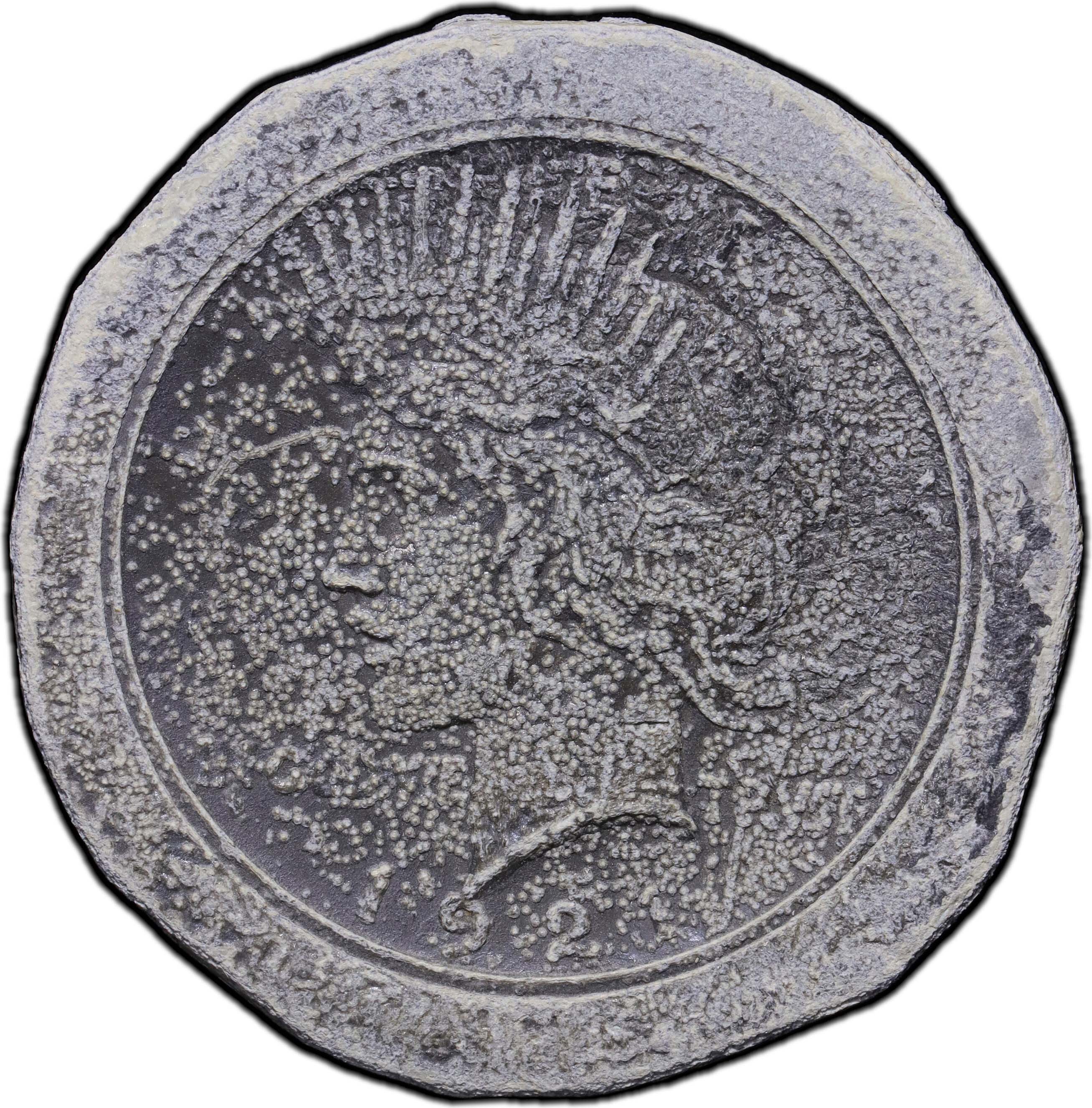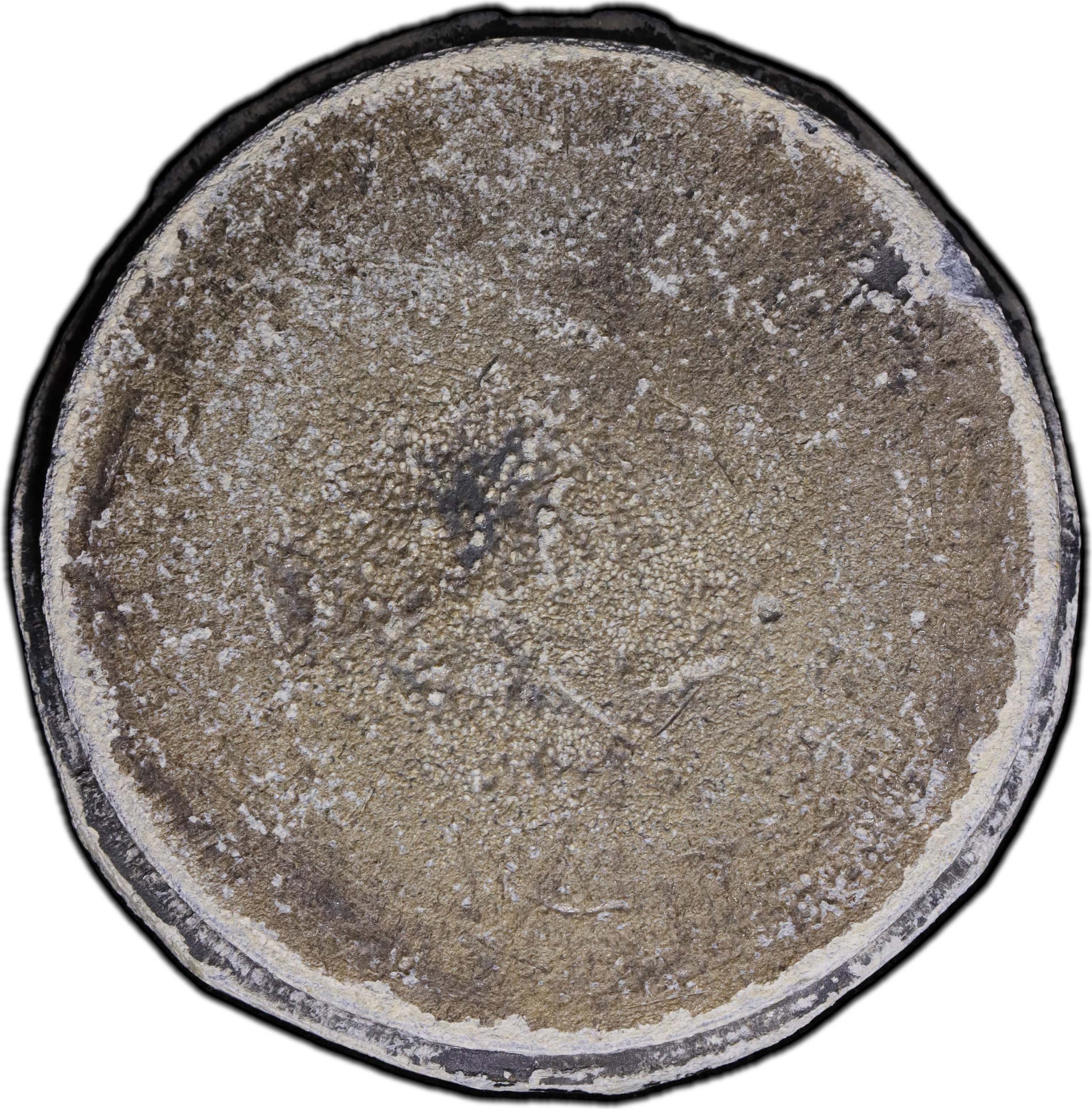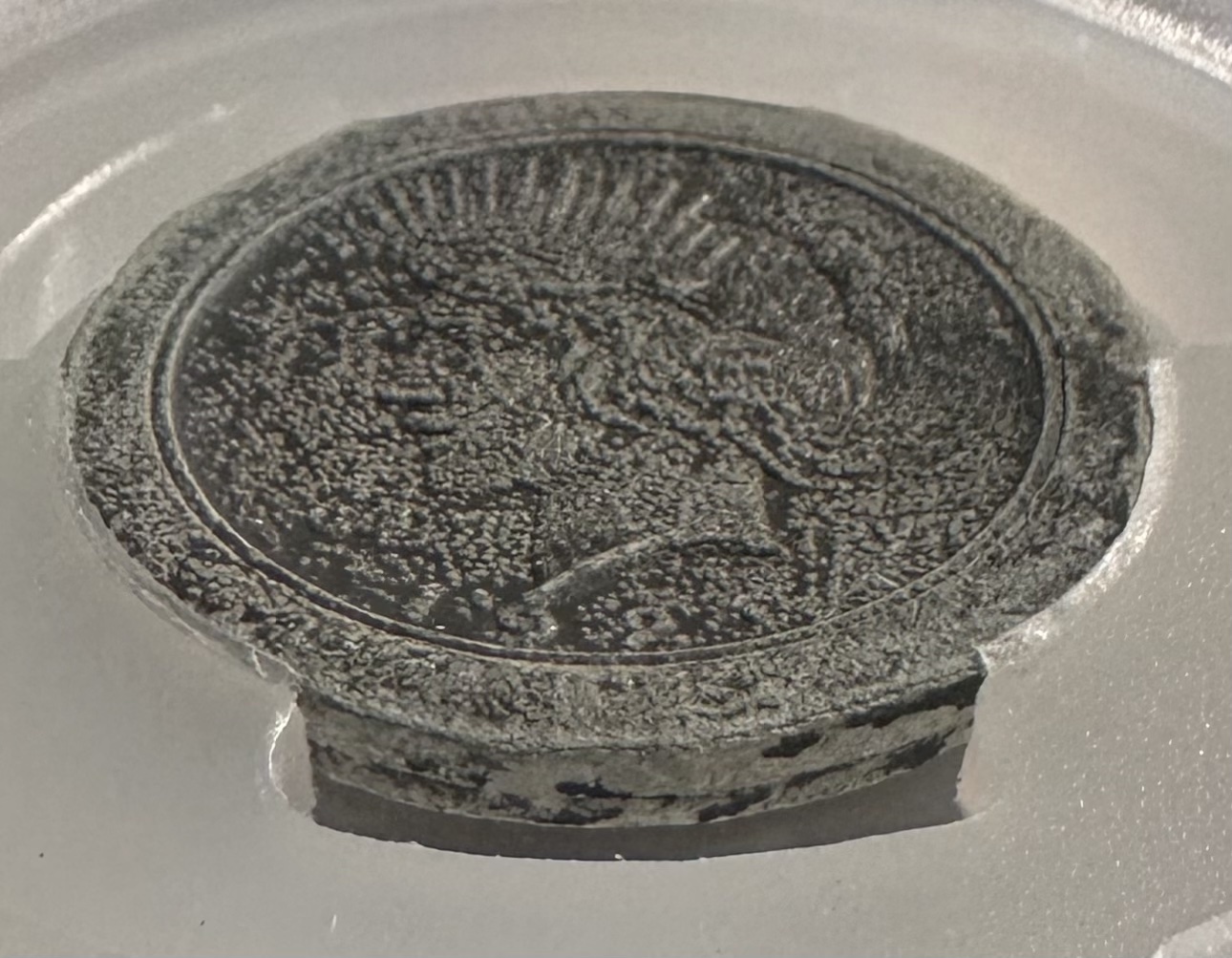Images Courtesy of Heritage Auctions, HA.com
1921 Peace Dollar Reverse Bronze Cast
Original Approved Broken Sword Design



1921 Peace Dollar Broken Sword Reverse Bronze Cast, Uncertified. In December 1921, Anthony de Francisci's design for the new Peace dollar was approved for coinage, and the sculptor had James Fraser in New York get bronze casts of each side produced to be sent to the Mint at Philadelphia along with plaster models of the same. The reverse portrayed a proud eagle clutching a broken sword and olive branch in its talons, symbolizing the dawn of peace following war. At least one bronze cast of this reverse was made, in New York, and at least a couple electrotypes (or "galvanos") were made from the plaster model, at the Mint. All known galvanos of the design are housed in the Mint's historical archives. Heritage is proud to offer the one known bronze cast of de Francisci's Broken Sword design in its first public auction appearance.
Origin of the Broken Sword Design
An Essay by Roger W. Burdette
In late November 1921 Anthony De Francisci was invited to join seven other sculptors in creating designs for a "standard silver dollar of such design shall be known as the "Peace Dollar,"[1] as envisioned by the Commission of Fine Arts. Everyone submitted their designs by the December 12 deadline.
After much deliberation by the commission members and negotiation between Chairman Charles Moore, Jim Fraser and Herbert Adams, the award was unanimously made to 34-year-old Anthony de Francisci, sculptor, of New York City.[2]
The 34-year-old sculptor's work was judged the best by the Commission of Fine Arts and its sculptor member James Earle Fraser. The obverse is similar to the final version but has the date in Roman numerals - MCMXXI. De Francisci chose to enter two different styles of reverse design: one with a placid, benign eagle holding an olive branch, and the other with an aggressive, bellicose eagle breaking a sword.[3] The placid eagle is similar to one he prepared for a Verdun City medal, while the aggressive eagle clearly borrows from his mentor, Adolph Weinman.

The obverse portrait of Liberty was modeled on classical themes (Saint-Gaudens' Victory bust) and after his 22-year-old wife Teresa,[4] and the reverse included an eagle standing on a mountaintop viewing a new dawn of peace. The commission made the award to de Francisci with the understanding that he would prepare finished models under the direction of Fraser, and that the models would then be approved by the Director of the Mint Raymond T. Baker.
De Francisci, Fraser and Baker met in Washington on the 15th to review the designs in person. This also gave Baker an opportunity to reinforce the very tight deadline the mint had to complete its work. Baker approved the designs on condition that additional changes were made. After recommending changing the date to European digits, and removal of the periods before and after the date, Baker requested another alteration. He wanted the broken sword from the alternate reverse model incorporated into the final reverse design.
De Francisci worked on the final models through Saturday and completed them on Sunday, December 18. When complete, Liberty's mouth and chin were altered to make them less massive, the date style changed, and the artist's monogram was added above the date.
The reverse was altered by making the eagle broader at the shoulder and bringing its neck and head more erect, making the bird look stronger and more alert. Borrowing from the rejected reverse, the eagle now grasps a sword with the tip broken off as well as holding a larger sprig of olive. The intent was to signify destruction of the implement of war (the sword) and the initiation of peace (olive branch). To further reinforce the symbolism, the word PEACE was added at the base of the mountain, although there was no specific authority to add the word to the coin.[5]
All involved evidently thought the broken sword was a clear symbol of the end of hostilities and of arms limitations. It had been used on several art medal designs in this context without dissent. No one who approved the design realized that a broken sword also carried a different meaning for soldiers.

He made two sets of seven and one-half-inch diameter plaster models and left one set with Fraser in New York. The second set and the sketch models he took with him to Washington for final approval the next day.
Models were shown to Director Baker, Under Treasury Secretary Seymour P. Gilbert, Jr., then Treasury Secretary Andrew W. Mellon, and finally to President Warren G. Harding. All eagerly approved and work began that afternoon. De Francisci telephoned Fraser in New York and Fraser took the models to Roman Bronze Co. in NYC to have bronze casts made.[6]
The Peace dollar project was going extremely well. Not only had a good design been selected but everything was on schedule; everyone from the president on down was pleased with the design and the efficient manner in which the commission and mint had worked together. The plaster models and obverse bronze cast arrived at the Philadelphia Mint on December 21, but there was a little bad news:
"I beg to advise you that we received at 2:30 P.M. today the plaster casts of both sides, and bronze castings of the obverse side of the models for the "Peace Dollar". The messenger who delivered these models stated to Mr. Morgan that Mr. Fraser said that the casting was poor, and suggested that we get an electrotype from obverse as well as the reverse side and if better than the one made in New York, to use it. Mr. Morgan is of the opinion that Mr. Fraser meant the casting was a little rough but he thinks it is not so much so as to give us trouble in reduction.
"The bronze casting of the reverse was a failure and we must now get our electrotype [for reduction] from the reverse plaster cast here. It would be impossible to get electrotypes of both sides and make our reductions in time to produce coins this year. Mr. Morgan is quite satisfied that he will be able to get a satisfactory reduction from the casting made in New York."[7]
With Morgan's reassurance that he could make a suitable reduction from the obverse cast, things were back on track, or so they seemed.
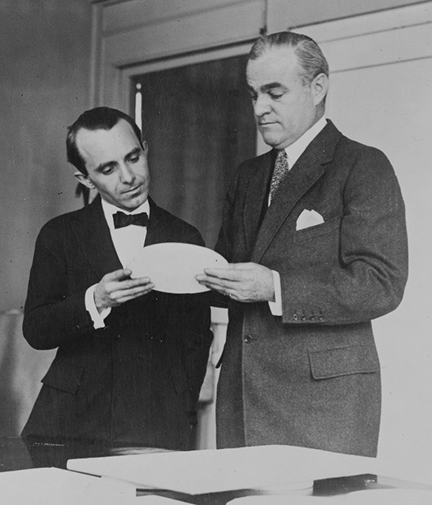
Evidently, the press release distributed with the "grip 'n' grin" photos of Baker and de Francisci described the reverse as having, "...a large figure of an eagle perched on a broken sword, and clutching an olive branch bearing the word 'peace.'"[8] No photos of the designs were released presumably because treasury officials felt it was illegal for newspapers to publish a picture of a United States coin.[9]
A Sword Without Honor
An early edition of the December 21st New York Herald printed a scathing editorial that changed everything.
"The Broken Sword:
"A new silver dollar, intended to be symbolic of the era of peace, is about to be minted by the Government. This is a good idea, but many Americans must read with regret that the designer, in his effort to picture the idea behind the Washington arms conference, represents the American eagle as standing on a broken sword.
"If the artist had sheathed the blade or blunted it there could be no objection. Sheathing is symbolic of peace; the blunted sword implies mercy. But a broken sword carries with it only unpleasant associations.
"A sword is broken when its owner has disgraced himself. It is broken when a battle is lost and breaking is the alternative to surrendering. A sword is broken when the man who wears it can no longer render allegiance to his sovereign.
"But America has not broken its sword. It has not been cashiered or beaten; it has not lost allegiance to itself. The blade is bright and keen and wholly dependable.
"It is regrettable that the artist should have made such an error in symbolism. The sword is emblematic of Justice as well as of Strength. Let not the world be deceived by this new dollar. The American effort to limit armament and to prevent war or at least reduce its horror does not mean that our sword is broken."[10]
The Herald's comments hit a responsive chord with readers. The Great War was still too immediate for the public to have patience with its artists. Symbols, which in other times or other contexts, might be more deeply understood, retained the stark, absolute meanings from wartime propaganda. The sword on de Francisci's alternate reverse design was in the process of being destroyed or blunted, but as used on the Peace dollar its tip was broken off and thus interpreted as a symbol of American defeat.[11] Letters objecting to the broken sword began to flow to the treasury, the mint and the Commission. A correction had to be made.
Saving the Peace Dollar
Late on December 22, Fraser, Moore and O'Reilly discussed what could be done to correct the "broken sword" problem. There was no time to make a plaster model of another design and have coins struck bearing the 1921 date; the reverse hub was being cut from the electrotype. Director Baker was on his way to San Francisco at the time and it is probable that mint staff telephoned him as O'Reilly requested.[12]
Baker was sent a follow-up telegram at 2:24 a.m. December 23:
"My Dear Mr. Baker:
"If you deem it advisable under the present criticism the broken sword could be removed from the hubs before dies are made. That would leave the design as it was originally, simply a peace coin. It would also obviate all criticism from the broken sword idea. I should like this as well without the sword.
"Yours truly,
"J. E. Fraser"[13]
Early on the morning of December 23, the sculptor was asked by Fraser to go to the Philadelphia Mint and supervise removal of the broken sword from the hub. Morgan was going to do the die-cutting work but, it was important to have de Francisci there to approve the results. Superintendent Styer later recalled:[14]
"Mr. Francisci personally visited the Mint and remained the greater part of the day while the Engraver was cutting the broken sword out of the dies....I feel it was important to have him here while the Engraver was removing the broken sword from the dies, and to obtain his approval after its removal."
The meticulous work was done under magnification with very fine engraving tools - not the kind of thing de Francisci or Fraser was skilled at doing. Only the steady, experienced hand of George Morgan could turn the situation from failure to success. Morgan had to do more than remove the broken sword, he had to strengthen the rays, then cover as much of the re-engraving as possible so that the change was not noticeable. Part of the work was done on the hub and part on the master die. To help hide the alteration, he extended the partial olive branch which extended from behind the broken end of the sword, back to the original part of the branch. He also removed the piece of stem protruding to the left of the eagle's talon and sharpened the leg and foot.[15]
By late afternoon Mary O'Reilly sent a letter to secretary Mellon:[16]
"Sir:
"I have the honor to submit models of the proposed designs for the Standard Silver Dollar.
"A slight alteration of the design for the reverse, as originally submitted, has been made in order to eliminate the broken sword, and the modified design is submitted for your approval.
"The model as now submitted has the approval of the Fine Arts Commission, and is in compliance with the requirements of the law.
"Respectfully,
"R. T. Baker, Director of the Mint"
Mint engraver Morgan touched up the lettering and in doing so, created the "slant-top A's" used inconsistently on the reverse of the 1921 coins. Morgan's work was of such high quality that it took more than eighty-five years for anyone to detect alteration on the 1921 hubs and dies.
[1]CFA, NARA-DC, RG 66, meeting minutes June 9, 1921, item 4.
[2]NARA-DC, Commission of Fine Arts, RG 66, 13-EZA, box 144, Peace dollar file. Letter dated December 17, 1921 to Moore from Fraser.
[3]NARA-CP, RG104 Entry A1 328N, box 4.
[4]CFA, NARA-DC, RG 66, meeting minutes December 13, 1921, item 1. Mostly her hair.
[5]In 1906 Saint-Gaudens had suggested adding the words Law or Justice to the double eagle. This was rejected because it would have required Congressional approval.
[6]NARA-CP, RG104 Entry A1 328N, box 4. Letter dated December 26, 1921 to Baker from Fraser. He lists $30 in travel expenses and "...an added expense of $30.00 for two bronze casts of the models of the Peace dollar."
[7]NARA-CP, RG104 Entry A1 328N, box 4. Letter dated December 21, 1921 to Baker from Philadelphia Superintendent Fres Styer.
[8]NARA-DC, RG 66, December 20, 1921 press clippings from the New York Times, Christian Science Monitor (Boston), Washington Evening Star. The articles are nearly identical, suggesting that they all were based on the same press release.
[9]De Francisci made such a request December 27 on behalf of Miss Rilla E. Jackman of Syracuse, New York, who wanted to use photos of the Peace dollar and Maine Centennial coins in a lantern slide presentation she was preparing. The Philadelphia North American also wanted to print photos of the new coins and was told by acting director O'Reilly, "Against law to photograph coins." (Telegram dated December 28, 1921.)
[10]CFA-Peace, NARA-DC, op cit. December 21, 1921 press clipping from the New York Herald.
[11]An obvious problem was Treasury's failure to release both design pictures and press announcement after the president had approved the design. None of the newspaper clippings from late December to early January, 1922 include photos of either the models or the coins. However, the omission was intentional: treasury officials felt it was illegal to print a reproduction of a U.S. coin except in numismatic publications. On November 4, 1916, the mint director wrote to Adolph Weinman who had requested permission for a newspaper to print reproductions of his new dime and half dollar designs. The Director says: "Replying, I have to state that such reproduction would be in violation of law. I am enclosing herewith a copy of Section 171 of the Penal Code, for your information." On August 3, 1920 chairman Moore sent a letter to Fraser advising Fraser to ensure that anyone working on coin designs fully comply with the same Section 171 of the U.S. Code. Per advice of the Treasury Department, Moore understood that newspapers were prohibited from publishing coin designs. With specific reference to the Maine Centennial half dollar, Moore says, "...it is suggested that you call the attention of Mr. Francisci to this matter. He should return all designs, models and prints to you. No newspaper is allowed to publish a design of a coin."
[12]Joseph P. Tumulty; papers, Library of Congress, Manuscript Division. Box 16, folder 4. Telegram dated December 24, 1921 to Tumulty from Baker. This is a routine Christmas Greeting telegram sent by Baker from Oakland, California at 5:54 p.m. Since the cross-country train trip took approximately three days, Baker had to have left Washington late on the 21st - a day before the controversy flared and was solved.
[13]NARA-CP, RG104 Entry A1 328N, box 4. Telegram dated December 23, 1921 (2:24 AM) to Baker from Fraser. (Punctuation added.)
[14]US Mint, NARA-CP, op. cit. Entry A1 328N, box 4. Letter (excerpt) dated January 30, 1922 to Baker from Styer.
[15]The design as used is not exactly the same as that on what de Francisci claimed were the original models. Evidently, the artist decided to avoid controversy and made a substitute model. Careful examination indicates several differences between the models and the 1921 coins, most noticeably in the way the olive branches are connected. The artist may also have forgotten that the mint had altered the hubs not the models.
[16]US Mint, NARA-CP, op. cit. Entry A1 328N, box 4. Letter dated December 23, 1921 to Mellon from Baker. Gilbert approved the change for Mellon, and O'Reilly signed Baker's name to the letter. Whereabouts of these "models" - more likely lead trial strikes - is unknown.
The Present Broken Sword Bronze Cast
904 grams. 186mm diameter across the design face from rim to rim; 191-196mm diameter across the irregular back; 5mm thick. The design face of the casting is five times the diameter of a Peace dollar, and its relief is similarly five times as high as that of de Francisci's high relief 1921 design. Following reduction for the master hub of the design (which was the intended purpose of the bronze cast Fraser had made in New York), the casting would have produced a design with a relief of 0.030 inches. For comparison, Morgan dollars and all low-relief Peace dollars had reliefs on both sides of about 0.015 inches. The high relief Peace dollar of 1921 had an obverse relief of 0.030 inches, same as the Broken Sword casting of the reverse would have produced. However, the sans-sword reverse of the 1921 Peace dollar had a 0.015-inch relief. Apparently, during the reduction process, the Mint reduced the relief for the coin's reverse, likely due to concerns about the ability to strike the higher relief on both sides simultaneously.
Uniform chocolate-brown patina characterizes the obverse of the bronze cast, while the reverse shows additional variations of brown color as normal for bronze casts. Portions of the edge chamfer are elevated at the outermost edge and show old file marks from when the cast was made. The portions of the chamfer closest to the design face are uniformly curved inward, creating a gentle slope up to the design face.
There are few numismatic relics as intriguing or as rare as the various sculptors' models for the United States' most beautiful and storied designs. Whenever such pieces appear at auction, they excite collectors and open a window into a piece of numismatic history long obscured or forgotten. And yet, some of them turn up in unexpected places, apparently surviving by chance. Such is the case with this piece, which a Pennsylvania antiques "picker" reportedly discovered and then sold in 2016, not very unlike how a set of Standing Liberty quarter bronze casts was discovered in 2001 and sold into the market several years later. These things take time and care to authenticate.
After the present Broken Sword Reverse bronze cast for the Peace dollar was discovered, it was shown to John Dannreuther at a Long Beach Expo in 2018. Dannreuther examined it at length, and in August of that year signed a certificate stating: "In my opinion, and based on currently available information, the item pictured above is the genuine original bronze cast model prepared for the US Mint in 1921 by Peace Dollar sculptor Anthony De Francisci and James Earle Fraser."
Recently, preeminent numismatic scholar Roger W. Burdette provided further insight into the piece. In an analysis presented to the present cataloger, Burdette wrote:
"At the time this design was prepared, there were no public illustrations available - and not even a written description existed. After the reverse was revised to the version used for coinage, there still was almost no numismatic knowledge of the original design. Further, there were no photographs publicly available from which an imitation could be made, and no archival information had been located to fully explain the situation.
"The reverse design shown on the disc was approved for coinage in December 1921. ... A galvano from the Philadelphia Mint's historical items, similar in appearance to the subject item is known. This is shown at right, below, next

"Notice that the subject item and Mint's galvano are nearly identical except the Mint's seems to have a smoother surface and somewhat better separation between some letters and background (The Mint's photo has lower detail and sharpness than the subject item photo); other portions seem inferior in detail. The Mint's galvano has the beginning of a circular hole, but it does not pierce the galvano. (The purpose of the hole is not known although an obvious use would be to hang the piece on a small peg for display. However, de Francisci's medal display board used uniface electrotypes with screws soldered to the back. This avoided defacing the original cast or electrotype.) [Both the subject item and the Mint's galvano also have the same small flaw on the rim near the O in ONE, suggesting they were created from copies of the same plaster host model.] ...
"The subject item is consistent in appearance and design detail with the U.S. Mint's galvano. It also presents certain defects that might be similar to those in the bronze cast delivered to the Philadelphia Mint and referred to in Superintendent Styer's correspondence. Further, secrecy of the Mint Bureau and Treasury Department, and limited access to archival documents virtually eliminates any chance of the subject item being a counterfeit piece."
What is not known about this piece is whether it was ever in the personal property of its designer, Anthony de Francisci, or if it is indeed the only bronze cast of the Broken Sword reverse made. Some conclusions must be drawn from known correspondence, but these conclusions are not always absolute. The various metal versions of the Peace dollar reverse in the Mint's archives are all galvanos, as would be expected from Superintendent Styer's letter and the fact that the Mint lacked the ability to make 1:1 bronze casts from plaster models and had to use electrotypes as an alternative where necessary. Furthermore, while Fraser attempted to have at least one bronze cast of the Broken Sword reverse made in New York, after the public's negative reaction to reading about the Broken Sword design and the Mint's pivot away from it, neither he nor de Francisci would have had any direct incentive from the Mint to have additional bronze casts made. In more than a century, this is the only such piece to have surfaced, and it is a truly magnificent find. It is accompanied by the original Dannreuther-signed certificate.
Ex: Offered by a Pennsylvania antiques "picker" (2016); purchased by Daniel Carr via private treaty (2016); shown to John Dannreuther at a Long Beach Expo for evaluation (2018); opinion of authenticity signed by Dannreuther (8/6/2018); evaluated by Roger W. Burdette and deemed genuine "based on the body of information presented by [the owner] and from independent sources" (2/2025).



1921 Peace Dollar Plaster
Made by Anthony de Francisci

1921 Peace Dollar Plaster by Anthony de Francisci. In December 1921, Italian-American sculptor Anthony de Francisci won the Commission of Fine Arts competition to design the Peace dollar. The commission requested that the date be changed from Roman to Arabic numerals. According to Roger Burdette, author of Renaissance of American Coinage 1916-1921, de Francisco made the requested changes to two sets of models. He took one set with him to Washington, D.C., and the other set was left at James Earle Fraser's New York studio. The present lot is the modified obverse plaster left with Fraser. Fraser later gave it to Victor Anthony de Meo, a photographer who worked with Fraser on projects such as the celebrated End of the Trail sculpture, or William de Meo, the son of Victor Anthony de Meo. William de Meo was an apprentice for Fraser and later opened up his own New York studio. The plaster is made of white alabaster with a yellow-ochre finish. It has a 222 mm diameter and is 32 mm thick. The edge displays moderate chips, and there are occasional minor surface deposits. We thank minterrornews.com for information concerning the plaster and its associated splasher die trial.


1921 Peace Dollar Splasher in Lead
Judd A1921-1, Believed Unique, Unc Details
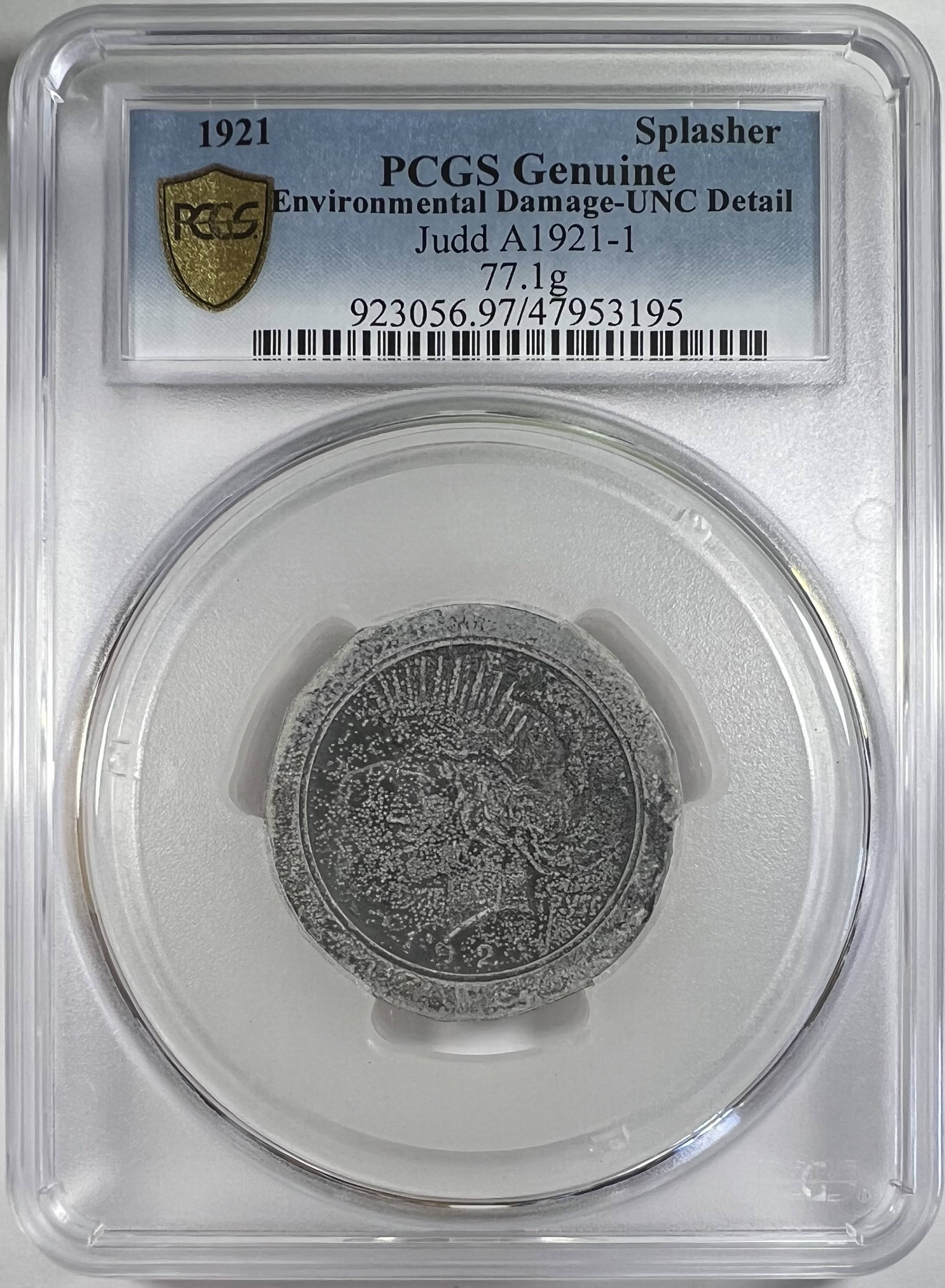

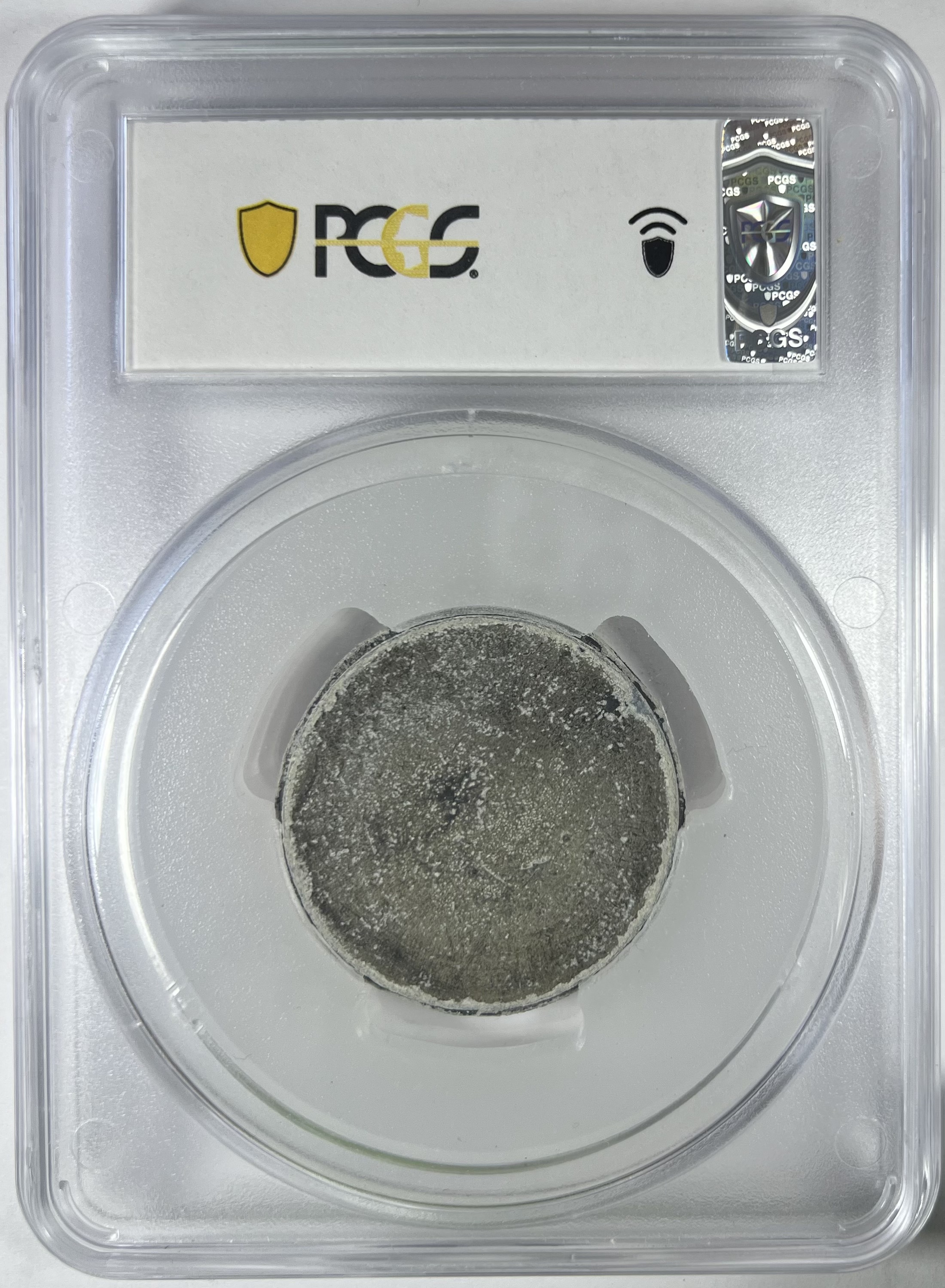
1921 Peace Dollar Obverse Splasher, Judd A1921-1, Pollock-Unlisted, Unique -- Environmental Damage -- PCGS Genuine. Unc Details. Lead. 77.1 grams. 45 mm diameter. 5 mm thick. In late 1921, sculptor Anthony de Francisci won the Commission of Fine Arts competition for the Peace dollar. He arrived at the Philadelphia Mint a few days before Christmas, and worked with Chief Engraver George Morgan to finish the design.
Roger Burdette in A Guide Book of Peace Dollars notes a December 23 letter from Mint Director R.T. Baker to Treasury Secretary Andrew William Mellon about the submission of models for the Peace dollar. Burdette states the models were "likely lead splashers or small plaster casts, there being no time to harden the hubs and make dies." Andy Lustig concluded the present splasher "is a genuine U.S. Mint product" with highly concave fields and a squared rim unlike a typical 1921 Peace dollar. The splasher has oxidized and has a beaded appearance. The present splasher was retained by Anthony de Francisci, and possibly passed through the ownership of James Earle Fraser and Victor Anthony de Meo. Fraser was a contemporary of de Francisci, and de Meo was a photographer who worked with Fraser. de Meo's son, William de Meo, was an apprentice for Fraser, and later owned the splasher.


